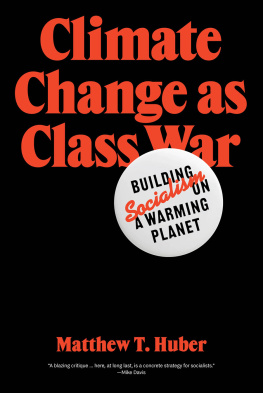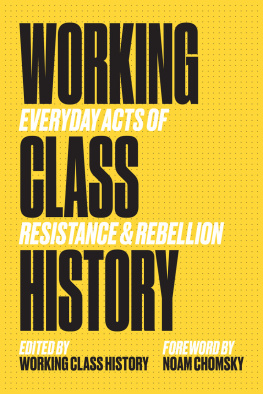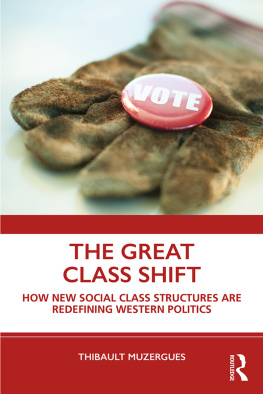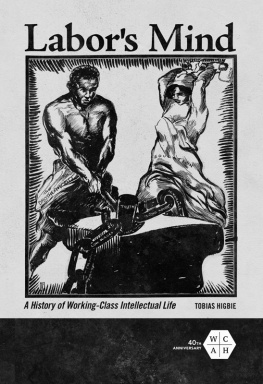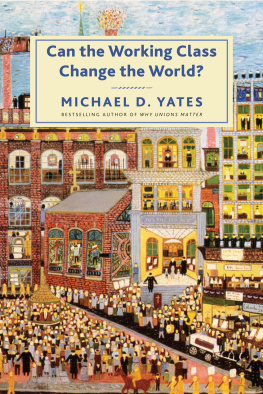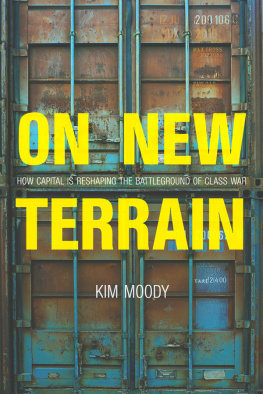THE WORKING
CLASS
MAJORITY
Americas Best Kept Secret
Second Edition
Michael Zweig
ILR PRESS AN IMPRINT OF
CORNELL UNIVERSITY PRESS ITHACA AND LONDON
Contents
Preface to the Second Edition Acknowledgments Introduction The Class Structure of the United States What We Think about When We Think about Class Why Is Class Important? Looking at the Underclass Looking at ValuesFamily and Otherwise The Working Class and Power Power and Globalization Power and the Government Into the Millennium Notes
Preface to the Second Edition
This second edition brings to the reader the latest data available in mid 2011, data that confirm the findings of the first edition. Some examples are new, while original examples that remain appropriate continue to be included. The structure of the book is unchanged, but individual chapters reflect new developments and findings.
Chapter 1 confirms the original finding that the working class is the majority in the United States. But while the overall percent of the labor force in the working class remained essentially unchanged (63 percent in 2010 compared with 62 percent in 1996), changes in details suggest two offsetting trends. The percent of the labor force engaged in traditional working class occupations has declined, particularly among clerical, precision production, and craft workers, as well as operators, fabricators, and laborers. At the same time, traditional middle class occupations among administrative, managerial, and professional titles increased their share of the workforce. Taken together, these trends would suggest that the working class is shrinking as increasing numbers of people have left working class jobs to come into positions of authority in the growing middle class. But that is not the case.
During this time period significant changes have come to the professions. As described more fully in chapter 1, traditional middle class professions like teaching and nursing have come under the discipline of corporate management in substantial numbers, resulting in a class shift within the professions. When we take into account the growing fraction of teachers, nurses, and other professionals who once had the autonomy and authority that made them part of the middle class, but who have since been subject more closely to the type of supervision characteristic of the skilled working class, the overall fraction of the labor force in the working class has remained virtually unchanged. The unchanged percent of people in the working class masks these two important developments: the disappearance of many traditional working class jobs and the simultaneous deterioration of the working lives of the professional middle class. Each of these contributes to the widespread sense of insecurity as the U.S. workforce moves further into the twenty-first century.
Several other new developments appear in subsequent chapters. While poverty has continued to inflict much suffering since the 1996 federal welfare reform legislation, and increased after the 2008 financial crisis, poor people have largely disappeared from mainstream political conversation. Chapter 4 examines the continuing burden of poverty, but looks at the ways many politicians, pundits, and media outlets have substituted immigrants for the poor as scapegoats for social ills, and as false targets for popular anger and frustration.
Chapter 6 newly introduces several social norms that flow from working class values, norms that provide concrete goals for specific policies that would advance the interests of working people. Chapter 7 now includes discussion of the global financial crisis in 20082010, new international government and economic relations, immigration to the United States, and the wars in Iraq and Afghanistan, all of which have occurred since the first edition appeared. In chapter 7, and in chapter 1, I consider the steady internationalization of class, whether among the capitalist class or the working class.
In chapters 6, 8, and 9, I look at changes that have taken place in the labor movement since the early days of John Sweeneys leadership of the AFL-CIO, when the first edition appeared. Chapter 9 now also presents a more detailed history of the rise of corporate power in response to labors advances during the New Deal and 1940s and 1950s, especially following 1970.
Developments in the Internet have already made obsolete the listings in the original printed Appendix. In its place, you can find links to relevant organizations on the books website, WorkingClassMajority.org , which also presents study guides for each chapter.
In preparing this second edition I have become sharply aware that almost everything it addresses is in the process of continuous development. Our economy and broader society are moving targets that cannot be properly described in a particular state over any length of time. While underlying class dynamics change only slowly, except in rare moments of radical social upheaval, the manifestations of these dynamics appear in new ways every year, if not almost every day. The rapidity with which circumstances change can make it more difficult to discern the more stable underlying class dynamics that largely drive events. Clarifying these underlying dynamics is the purpose of this book.
Updating and elaborating our understanding of this ever-changing presence of class must be a collective undertaking of continuous investigation, writing, and debate. As this book is used in classrooms, union halls, study groups, and community centers, I hope that students, working people, faculty researchers, and others involved in these issues will continue the work of updating and deepening our understanding of class based on the study of new data and examples. I hope their results will be presented and debated at Working Class Studies Association conferences and other gatherings of labor-oriented people, and published in popular venues and professional journals as working class studies becomes an accepted part of our public dialogue. Together we must come to better understandings of how class works to shape our life experiences, and how our knowledge of class can help us influence history to the advantage of working people.
Acknowledgments
In planning and writing this book I have benefited from the insight, experience, and challenging ideas of many people. For their interest and encouragement, and for their time taken for discussion, reading and commenting on various drafts of this second edition, looking up information, and helping me find my bearings in this material, I thank Joe Berry, Ron Blackwell, Jim Borbely, Ross Borden, Gene Bruskin, Jeff Crosby, Fernando Gapasin, Penny Lewis, Stephanie Luce, Maria Maisto, Jay D. Mazur, Jack Metzgar, Rachel Micah-Jones, Dennis ONeil, Steven Pitts, Warren Sanderson, Heidi Shierholz, Craig Smith, Megan Smith, Ralph Tricoche, Luis Valenzuela, Victor Wallis, Kris Warner, Devon Whitham, and Anne Wiegard. Robert Saut provided invaluable research and helped me think through some thorny questions. The State University of New York at Stony Brook granted me a years sabbatical leave that made it possible to do this work. My thanks also to the staffs of Stony Brook Manhattan and the Joseph S. Murphy Institute for Worker Education and Labor Studies at the City University of New York for providing me with stimulating and productive work environments.
I continue to be grateful to all who helped create the first edition of this book: anonymous reviewers for Cornell University Press, Doug Andersen, Stanley Aronowitz, Ruth Ben Zvi, Mike Bianculli, Keith Cummings, Debra Dwyer, participants in the Economic Policy Institute Friday seminar, Frank Emspak, Bill Fletcher, Elaine Fuller, David Gold, Ted Goldfarb, Paul Groncki, Eduard Gros, Barbara Haber, Elaine Harger, Doug Henwood, Takashi Kamihigashi, Barrie Kelly, Eugene Kelly, Glen Koster, Marta Kusic, Judith Lang, Les Leopold, Jon Levine, Robert Lepley, librarians at the Tamiment Collection and Business and Social Science Reference Desk at Bobst Library of New York University, Theresa Li Cascia, Jay D. Mazur, Larry Mishel, Ruth Misheloff, Christopher Mittendorf, Stan Nadel, Jim OBrien, Bertell Ollman, Dennis ONeil, Greg Palast, Paddy Quick, Michael Reich, Jimmy Rich, Sumner Rosen, Elissa Sampson, Warren Sanderson, Elisabeth Sawyer, Danny Schechter, Bill Scheuerman, Michael Schwartz, Barbara Silverstone, Jane Slaughter, Roland Spant, Bill Tabb, Nick Unger, Dick Wheeler, and Gekee Wickham. Kathy Chamberlain offered wise counsel from the earliest days of this work to final editing of both editions. Fran Benson, my editor at Cornell University Press, believed in this project at an early stage. Without her support, you would not be reading this book.
Next page


